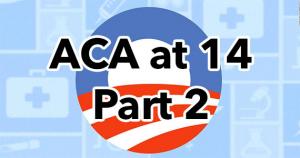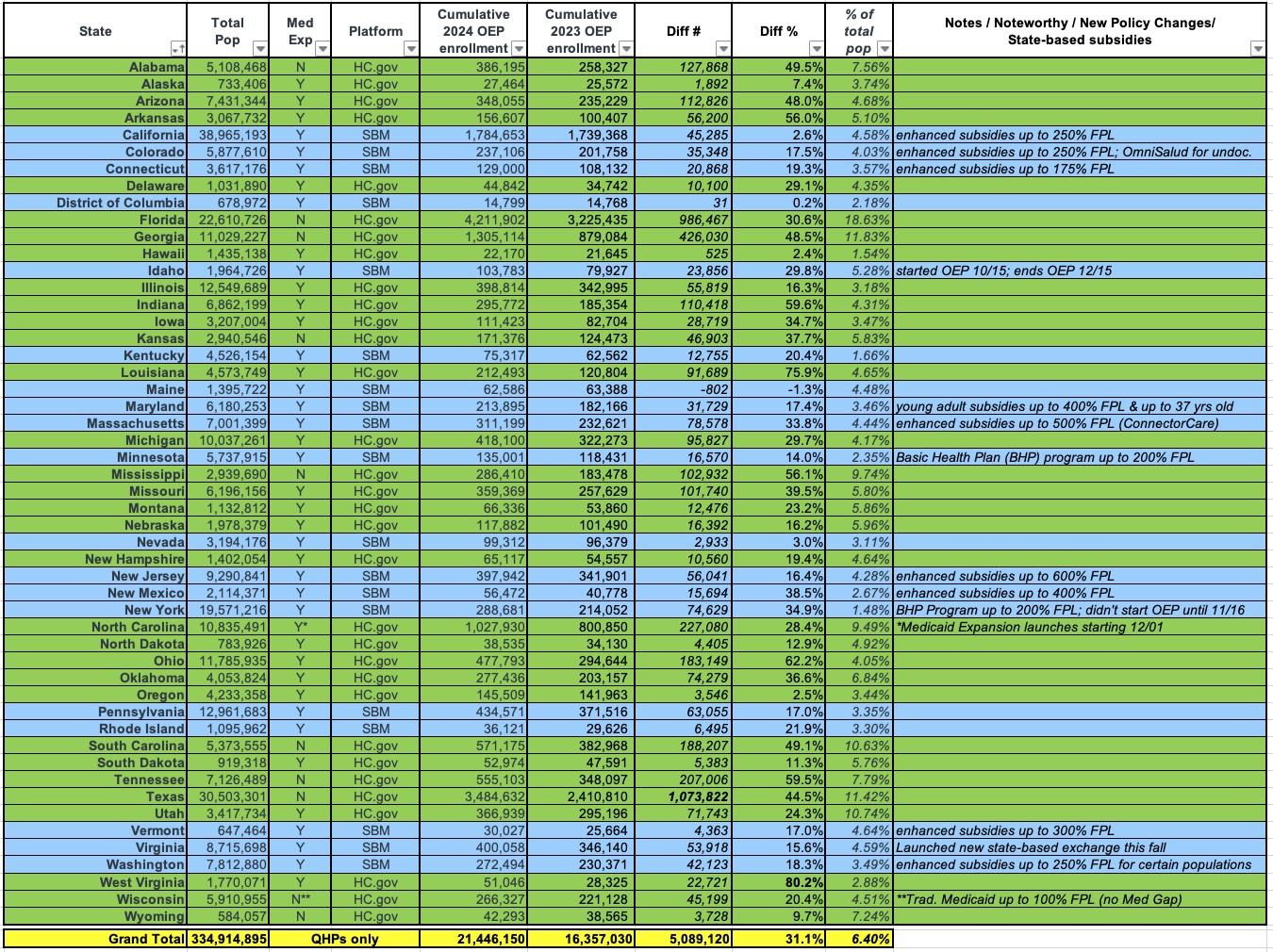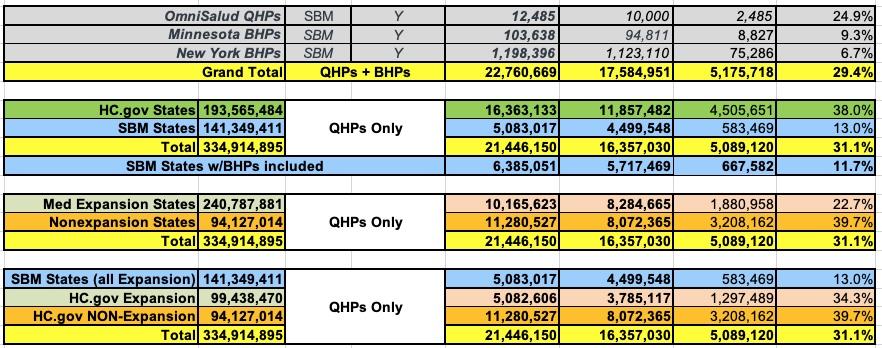Happy Birthday #ACA! (Part 2: Topline Numbers)

Part 1 | Part 2 | Part 3 | Part 4 | Part 5 | Part 6 | Part 7
Moments ago the Centers for Medicare & Medicaid Services (CMS) posted the official 2024 ACA Open Enrollment Period Public Use Files. Let's dig in!
The table below has the data for both Qualified Health Plans (QHPs) in all 50 states + DC as well as Basic Health Plan (BHP) enrollment in Minnesota and New York only, compared to the 2023 OEP.
I've also thrown in (on a separate line) around 12,500 "OmniSalud QHP" enrollees in Colorado; this is a special program specifically designed for undocumented immigrants and DACA recipients who aren't eligible to enroll in coverage via the official ACA exchange. It utilizes a separate web portal and separate financial assistance provided entirely by the state, not the federal government. While the insurance policies are the same as QHPs, they aren't counted as part of the official CMS tally,
I've also grouped the data by type of ACA exchange (federally facilitated or state-based) and by Medicaid expansion status. The main takeaways are pretty much the same as I've written about earlier this year, with some slight modifications as the final numbers have come in:
- Overall QHP enrollment is up 31.1% y/y
- Overall BHP enrollment is up 6.9% y/y
- Federal exchange enrollment is up 38% y/y
- State-based exchange enrollment is up 13% y/y without BHPs (up 11.7% w/BHPs included)
Since Medicaid expansion "cannibalizes" a large chunk of enrollees who'd otherwise be eligible for QHPs (similar to how BHPs do), that's another important factor:
- EXPANSION state enrollment is up 22.7% y/y
- NON-expansion state enrollment is up 39.7% y/y
Since every one of the states with their own exchange has also expanded Medicaid, this means you have to break it out further:
- State-based exchanges: Up 13% y/y (or 11.7% w/BHPs)
- Federal exchange EXPANSION states: Up 34.3% y/y
- Federal exchange NON-expansion states: Up 39.7% y/y
So the state-based vs. federal exchange gap is considerably smaller: Up 9.9% vs. down 2.1% (or up 1.6%).
Some key state numbers:
- Highest y/y QHP enrollment increase by percentage: WEST VIRGINIA, up a stunning 80.2%!
- Six other states saw enrollment increase of more than 50% y/y: LA ,OH, IN, TN, MS & AR
- Highest y/y QHP increase by sheer number: TEXAS, up a jaw-dropping 1.07 MILLION (+44.5%)
- Eleven other states saw enrollment increases of more than 100,000: FL, GA, NC, TN, SC, OH, AL, AZ, IN, MS & MO
At the opposite end:
- MAINE is the only state to see a net drop in enrollment year over year, of 1.3% (-802 enrollees). However, this was explained by the state a few weeks ago: The state had quietly further expanded Medicaid to young adults aged 19 - 21, shifting around 1,300 exchange QHP enrollees over to Medicaid instead. If those 1,300 had remained in exchange plans, 2024 enrollment would have been up slightly (perhaps 0.8% or so).
- Other states had a 5% y/y enrollment increase or less: Nevada, California, Oregon, Hawaii, District of Columbia
Three of these operate their own exchanges, but the other two (Oregon and Hawaii) don't (although both of them did a long time ago, interestingly).
Florida once again has by far the highest percent of its total statewide population enrolled in ACA exchange QHPs: 18.6%, or 1 out of every 5.4 Floridians. Part of this is due to them not expanding Medicaid, but no other non-expansion state has more than 12% of their populations enrolled in exchange plans.
At the opposite end is Hawaii: Just 1.5% of its total population is enrolled in an on-exchange QHP. New York technically only has 1.5% as well, but again that doesn't include BHP enrollees; throw them in and they're at 7.6% of the state population.
How to support my healthcare wonkery:
1. Donate via ActBlue or PayPal
2. Subscribe via Substack.
3. Subscribe via Patreon.





